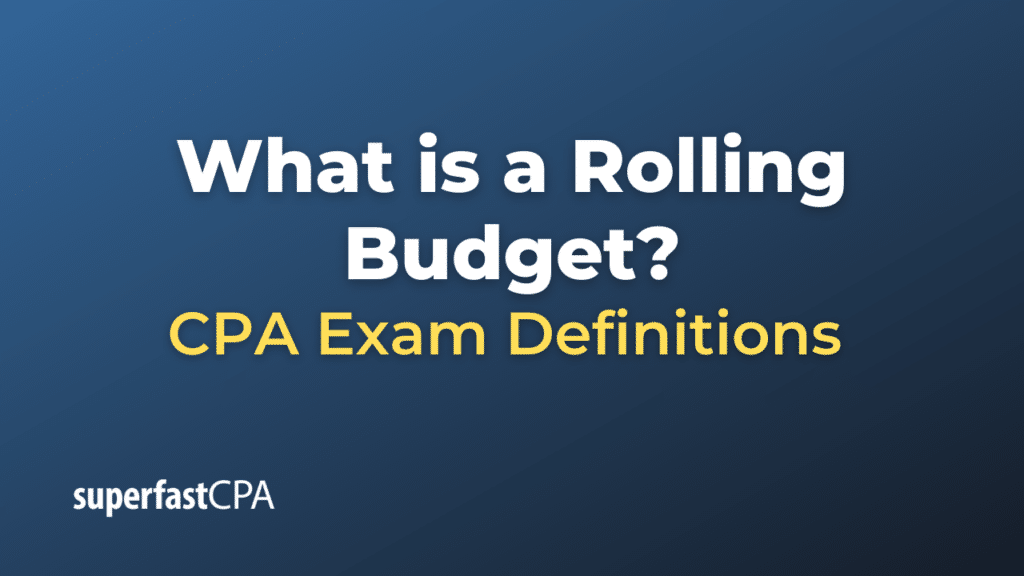Rolling Budget
A rolling budget, also known as a continuous budget or rolling forecast, is a financial planning tool that continuously extends the budget period by one month (or another chosen period) as each month (or period) passes. This method provides a constantly updating forecast that offers a forward-looking perspective at all times.
Here’s a simplified breakdown of how it works:
- Initial Period: At the start, a rolling budget may be set for 12 months, just like a traditional annual budget.
- End of First Month: At the end of the first month, the actual results for that month are compared against the budget. Then, a new month (the 13th month in the future) is added to the budget, so the budget still covers a 12-month span. This process is repeated at the end of each subsequent month.
- Continuous Update: As each month ends, that month drops out of the budget, and a new future month is added, ensuring that there’s always a 12-month (or other chosen period) forecast in place.
Advantages:
- Relevance: Since it’s continuously updated, a rolling budget is always current and can be more relevant to changing business conditions.
- Flexibility: This method allows for adjustments based on recent performance or changes in the external environment.
- Encourages Regular Review: Continuous budgeting prompts regular reviews of financial performance and assumptions, fostering proactive decision-making.
- Reduced “Budget Padding” : With annual budgets, departments might inflate their budgets to ensure they have enough money for the entire year (often because unused funds might get reduced in the next annual budget). A rolling budget can reduce this behavior since there’s regular adjustment.
Disadvantages:
- Administrative Burden: Rolling budgets can be more administratively intensive because they require regular updates and reviews.
- Short-term Focus: Depending on how it’s implemented, a rolling budget might encourage a focus on short-term results rather than long-term strategic planning.
In essence, a rolling budget is a dynamic approach to financial planning and can be especially beneficial for businesses operating in rapidly changing environments. However, it may not be suitable for all organizations due to its administrative demands.
Example of a Rolling Budget
TechDynamics, a tech startup, decides to implement a rolling 12-month budget starting in January 2023 to be more agile in its rapidly changing market. The initial budget is set for January 2023 to December 2023.
January 2023:
- Budgeted Sales: $100,000
- Actual Sales: $110,000
TechDynamics experiences better-than-expected sales in January. The company reviews its performance at the end of January and compares the actual sales to the budgeted figures.
February 2023:
As January ends, TechDynamics drops January from its 12-month budget and adds January 2024. Given the stronger performance in January 2023 and new market intelligence, the sales forecast for some of the future months might be adjusted.
Rolling Budget for February 2023 – January 2024:
Now, instead of the budget ending in December 2023, it extends to January 2024. Every element of the budget (expenses, investments, etc.) gets updated in this rolling fashion, always providing a 12-month forward-looking window.
December 2023:
As each month in 2023 ends, that month gets dropped from the rolling budget, and a new month in 2024 is added. By December 2023, the rolling budget will be forecasting from December 2023 to November 2024.
Key Takeaway:
Throughout the year, TechDynamics continuously adapts its budget based on actual performance and changes in the business environment. Instead of waiting for the end of the year to adjust its strategies and projections, the company can make more timely decisions to capitalize on opportunities or mitigate challenges.
This proactive approach allows TechDynamics to stay ahead of market shifts, but it also means the finance team is frequently updating and reviewing budget figures, requiring more ongoing effort than a traditional annual budget.













